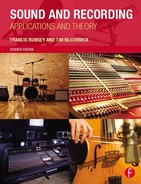Preface to the Seventh Edition
Since the sixth edition appeared in 2009 there have been significant developments in several fields, and revisions, updates and deletions have taken place in a number of areas. The digital audio chapters have been substantially revised and include such topics as parametric and high-resolution audio coding, recent interfaces, file formats and networks, the latest workstation audio processing technology, and issues concerning mixing ‘in the box’ (that is, entirely within the computer) and ‘out of the box’. Digital mastering issues such as loudness normalization and initiatives such as Apple’s Mastered for iTunes are also included. Audio network requirements and protocols for IP-based communication, for instance, RAVENNA, X-192, AVB and Q-LAN are covered.
After CD sales peaked in about 2000 there has been a year-by-year decline, counterbalanced somewhat by a growth in downloading activity. DVD sales burgeoned, and surround sound developments have been driven not by audio-only formats such as the quadraphonics and ambisonics of yesterday or the SACD of today, but by the audio-visual industry: film, DVD and the higher definition TV formats. Chapter 17 introduces an overview of some of the advanced immersive audio systems recently introduced and to an extent still under development. Those principally involved only with sound will inevitably find themselves working in the audio-visual field from time to time, and discussions of Wave Field Synthesis and Dolby Atmos in particular underline the issues concerning surround formats suitable for the professional or public arena and their relevance to the domestic environment.
Information specifically about analog recording, principally covered in Chapters 6 and 7, now occupies about 6% of the whole book. For those who have left analog behind for ever, or indeed have never even encountered it, its continuing presence for those who still find the information useful should not trouble them. When the first edition of this book appeared in 1992, no one would have predicted that vinyl would still be in use this deep into the present century nearly 40 years after LP sales peaked in 1978, and so an appendix has been allowed to remain which helps people to get the best from the format, and indeed to help avoid damage of literally irreplaceable hardware merely by playing it on poorly aligned equipment.
Chapter 3 includes a section on digital radio microphones, and Chapter 4 now includes a section on developments in loudspeaker sensitivity and the issues which confine this parameter within certain bounds. Also included is information about the highly directional ‘audio spotlight’ techniques.
Chapter 14 has been re-named ‘MIDI and Remote Control’ and reflects developments in the usage of computer networks to enable conventional-looking mixer control surfaces to communicate with computer-based recording and editing processes. It includes information about current thinking and co-operation by those developing and specifying systems, and looks specifically at the Open Control Architecture and AES64-2012 proposals. The Avid EuCon format is also covered which has been in the field for some years. These topics reflect the ever greater part the computer is playing in the sound industry.
For information on all Focal Press publications visit our website at: www.focalpress.com
Francis Rumsey and
Tim McCormick
